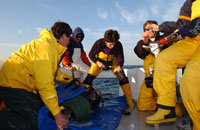Barb Block from the Shogun Expedition. Bluefin tuna must have good vision. After all, they warm their eyes with counter-current heat exchangers that keep the temperature of their retinas warmer than the water around them.
That's just one hypothesis as to why they won’t take our live baits, even when we present them on 20-lb fluorocarbon fishing line.
In the old days -- 1999 -- when we were collecting live tuna, our team would only use heavy gear for any size bluefin to reduce stress on the fish. Now, we use anything we can. Today, we worked the same waters we’ve pretty much been in the entire trip to find bluefin tuna naïve enough to bite our large sardine baits. We are pleased to tell you all that we did get 3 more bluefin in the 15-20 lb size range in our wells. But we felt a minor bit of frustration as every school of bluefin we approached either did not leave the anchovy bait ball it was on or barely noticed our sardine baits.
We know that the fish we are trying to collect -- young 2-year-old bluefin tuna -- were born in waters off Japan and swam across the Pacific this year to these waters. The archival tagging data shows that once they're here, most of these fish will ply our California Current waters for up to 3 to 4 years before they return to the western Pacific, presumably to spawn in the warm waters off southern Japan.
Some of the fish we’ve tracked, as small as 30 pounds, will swim back and forth across the Pacific and move to the Emperor Seamounts when production in the California Current is low. This confounds all our theories. For now, we’re focused on finding more bluefin of collecting size, and with the promise of good weather tomorrow, we hope to snatch a few more fish from the sea. I’m thinking smaller baits...and wondering how one rigs an anchovy. ABOARD THE F/V SHOGUN, Off San Diego, California.




No comments:
Post a Comment